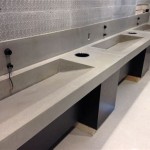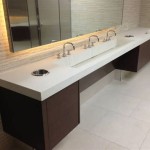Narrow Bathroom Vanity Sinks: Maximizing Space and Style
Narrow bathroom vanity sinks represent a crucial design element in bathrooms facing space constraints. These sinks, specifically designed with reduced dimensions, offer a practical solution for smaller bathrooms, powder rooms, and tight layouts where every inch counts. By choosing the right narrow vanity sink, it becomes possible to maintain functionality and aesthetic appeal without sacrificing valuable floor space. This article will delve into the diverse types, key considerations, and styling options associated with narrow bathroom vanity sinks.
Understanding the Need for Narrow Vanity Sinks
The growing demand for narrow vanity sinks aligns with the increasing prevalence of smaller living spaces and the desire to maximize usable area in existing bathrooms. Older homes are often equipped with bathrooms that were not designed with the same emphasis on spaciousness as modern constructions. Renovations of these bathrooms frequently involve the installation of compact fixtures to improve traffic flow and create a more comfortable environment. Similarly, new apartment buildings and condominiums often feature smaller bathrooms to optimize the overall building footprint. A standard-sized vanity in such spaces can render the bathroom cramped and uncomfortable.
Furthermore, the inclusion of additional fixtures, such as a second sink in a master bathroom, may necessitate the selection of narrow vanities. In these shared spaces, a streamlined design that incorporates two smaller sinks rather than one large one can enhance functionality without overcrowding the room. Beyond practical considerations, narrow vanity sinks can also contribute to the overall aesthetic of a bathroom by providing a minimalist and modern feel.
The term "narrow" in the context of bathroom vanity sinks typically refers to depths significantly less than standard vanity sizes. While standard vanities often range from 18 to 24 inches in depth, narrow vanities often measure between 12 and 18 inches or even less. This reduction in depth can create a noticeable difference in available floor space, allowing for easier movement and the integration of other bathroom elements.
Types of Narrow Bathroom Vanity Sinks
The market offers a variety of narrow bathroom vanity sinks, each with unique characteristics and installation requirements. Understanding these distinctions is crucial for selecting the most appropriate option for a specific bathroom layout and design preference.
Wall-Mounted Sinks: These sinks are directly attached to the wall, eliminating the need for a traditional vanity cabinet. Wall-mounted sinks are particularly advantageous in small bathrooms as they create an illusion of more space by exposing the floor beneath. They also simplify cleaning, as there are no hidden corners or hard-to-reach areas. The plumbing is often exposed, which may require additional attention to ensure it is aesthetically pleasing. Alternatively, a decorative shroud or bottle trap can be used to conceal the plumbing while maintaining a clean and modern look.
Pedestal Sinks: Pedestal sinks consist of a sink basin supported by a freestanding pedestal. This type of sink offers a classic and elegant look, making it suitable for both traditional and contemporary bathroom designs. While pedestal sinks do not provide built-in storage, they often have a smaller footprint than many other vanity options. This makes them ideal for powder rooms or bathrooms where storage is not a primary concern. The pedestal conceals the plumbing, creating a cleaner appearance compared to exposed pipes.
Corner Sinks: Designed to fit snugly into the corner of a room, corner sinks are an excellent solution for maximizing space in especially compact bathrooms. They effectively utilize otherwise wasted space and can be paired with a small vanity cabinet or mounted directly to the wall. Corner sinks are available in a variety of styles and materials, allowing for seamless integration with the existing bathroom décor.
Vessel Sinks: Vessel sinks sit on top of the vanity countertop rather than being recessed into it. This type of sink adds a unique visual element to the bathroom and can be particularly striking when paired with a narrow vanity cabinet. While vessel sinks can be stylish, it is important to consider their height in relation to the countertop to ensure comfortable use. The combination of a low-profile countertop and a relatively tall vessel sink can create a visually appealing and ergonomically sound design.
Vanity Cabinets with Integrated Sinks: These units combine a sink basin with a purpose-built vanity cabinet. While traditional vanity cabinets can be bulky, narrow vanity cabinets offer a compact solution without sacrificing storage. These cabinets often feature drawers or shelves for storing toiletries and other bathroom essentials. The integrated sink ensures a seamless and cohesive design, simplifying installation and providing a consistent aesthetic. Narrow vanity cabinets with integrated sinks are available in a wide range of styles and finishes, allowing for customization to match the overall bathroom design.
Key Considerations When Choosing a Narrow Vanity Sink
Selecting the appropriate narrow vanity sink involves careful consideration of several factors, including the bathroom's dimensions, existing plumbing, storage needs, and overall aesthetic style. Prioritizing these considerations ensures that the chosen sink not only fits the space but also fulfills its intended purpose effectively.
Measuring the Space: Accurate measurements are paramount before purchasing any bathroom fixture. Measure the available space for the vanity, taking into account door swing, toilet placement, and any other obstructions. Consider the depth of the vanity as well as its width and height. It is helpful to create a scale drawing of the bathroom layout to visualize the placement of the vanity and ensure that it will not impede movement or create a cramped feel. Pay particular attention to the space between the vanity and other fixtures to ensure adequate clearance.
Plumbing Location: The existing plumbing configuration will influence the type of vanity sink that can be installed. If the plumbing is already in place, it may be more cost-effective to choose a sink that aligns with the existing connections. Relocating plumbing can be a significant undertaking, involving additional costs and potential delays. Wall-mounted sinks and pedestal sinks, for example, often require specific plumbing configurations. If the plumbing needs to be altered, consult with a qualified plumber to ensure that the work is done correctly and in compliance with local building codes.
Storage Requirements: Consider the amount of storage space needed in the bathroom. While narrow vanities are designed to save space, some models offer more storage than others. Vanity cabinets with drawers and shelves provide concealed storage for toiletries, towels, and other bathroom essentials. Wall-mounted sinks and pedestal sinks, on the other hand, typically offer minimal or no storage. If storage is a priority, consider supplementing a wall-mounted or pedestal sink with additional storage solutions, such as wall-mounted cabinets or shelving units.
Style and Aesthetics: The style of the vanity sink should complement the overall design of the bathroom. Narrow vanity sinks are available in a wide range of styles, from traditional to modern, and in various materials, such as porcelain, ceramic, glass, and stone. Consider the existing color palette, tile patterns, and hardware finishes when selecting a vanity sink. A cohesive design will create a harmonious and visually appealing bathroom space. For example, a contemporary bathroom might benefit from a sleek, minimalist vanity sink made of white porcelain or glass. A more traditional bathroom might feature a pedestal sink with ornate detailing or a vanity cabinet with a stained wood finish.
Faucet Compatibility: Ensure that the chosen faucet is compatible with the selected vanity sink. Consider the number of faucet holes in the sink and the type of faucet required. Some sinks may have a single hole for a single-handle faucet, while others may have three holes for a widespread faucet. The style and finish of the faucet should also complement the overall design of the bathroom. Take into account the reach and height of the faucet spout to ensure that it is comfortable to use with the chosen sink. In addition, consider the water flow rate and efficiency of the faucet to conserve water and reduce utility costs.
Styling Options for Narrow Bathroom Vanity Sinks
Beyond the practical considerations, styling narrow bathroom vanity sinks effectively can elevate the overall aesthetic of the bathroom. Strategic use of accessories, lighting, and color palettes can transform a small space into a stylish and functional oasis. It's crucial to remember that even a well-chosen vanity sink can appear lackluster if not properly integrated into the overall design scheme. The design should create the illusion of more space.
Mirrors and Lighting: Mirrors play a crucial role in enhancing the perception of space in small bathrooms. A large mirror placed above the vanity sink can reflect light and create the illusion of a larger room. Consider using a mirror that extends the full width of the vanity or even spans the entire wall. In addition to mirrors, proper lighting is essential. Install bright, even lighting to illuminate the vanity area and eliminate shadows. Consider using recessed lighting, wall sconces, or a vanity light bar to provide adequate illumination. Layering different types of lighting can create a more dynamic and inviting atmosphere.
Color Palette: The color palette of the bathroom can significantly impact the feeling of spaciousness. Light and neutral colors, such as white, cream, and light gray, can make a small bathroom feel brighter and more open. Use darker colors sparingly, as they can make the space feel smaller and more enclosed. Consider using accent colors to add visual interest and personality to the room. For example, you could use a pop of color on the walls, in the accessories, or in the towels. Maintaining a consistent color scheme throughout the bathroom will create a sense of harmony and cohesiveness.
Accessories and Organization: Choose accessories that are both functional and stylish. Use countertop organizers to keep toiletries and other items neatly arranged. Consider using decorative soap dispensers, toothbrush holders, and trays to add a touch of personality to the vanity area. Avoid cluttering the countertop with too many items, as this can make the space feel cramped. Vertical storage solutions, such as wall-mounted shelves or cabinets, can help to maximize storage space without taking up valuable floor space. Consider using decorative baskets or boxes to store items on shelves or in cabinets.
Hardware and Fixtures: The hardware and fixtures in the bathroom should complement the style of the vanity sink and the overall design of the room. Choose hardware finishes that coordinate with the faucet and other fixtures. For example, if you have a chrome faucet, consider using chrome cabinet pulls and towel bars. Consider using sleek, modern hardware for a contemporary bathroom or more ornate hardware for a traditional bathroom. Pay attention to the details, as even small changes can make a big difference in the overall appearance of the bathroom.
By carefully considering these styling options, it is possible to transform a small bathroom with a narrow vanity sink into a stylish and functional space. The combination of thoughtful design choices, strategic use of accessories, and a cohesive color palette can enhance the perception of space and create a comfortable and inviting atmosphere.

Bathroom Vanity Vanities Sink Narrow Floating Live Edge

Narrow Bathroom Vanities A Simple Solution For Small

22 Inch Narrow Depth Console Bath Vanity Custom Options

Long And Narrow Bathroom Vanity Vanities Small Sinks

Narrow Depth Bathroom Vanities Signature Hardware

Bathroom Vanity Vanities Sink Narrow Floating Live Edge

38 Inch Single Sink Narrow Depth Furniture Bathroom Vanity

Acf C13 Grey Walnut By Nameek S Cubical Narrow Bathroom Vanity Floating 18 Thebath

Narrow Depth Bathroom Vanities Signature Hardware

Dear Emmeline Narrow Half Bathroom Reveal 1910 Home Renovation Small Sinks Vanities
Related Posts







